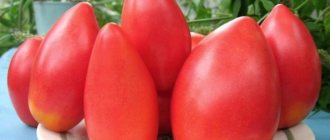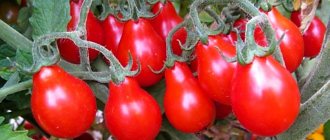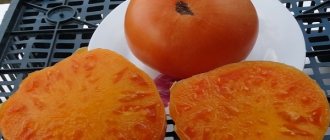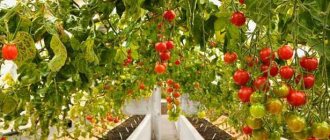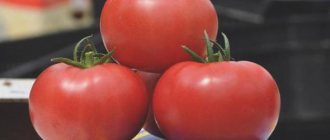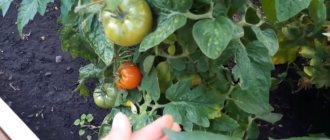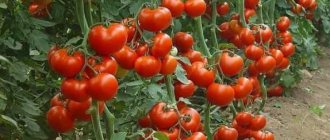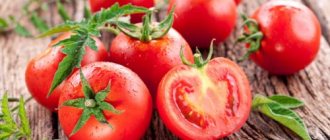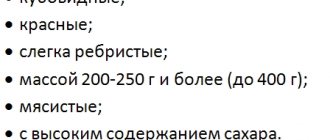Tomato Emperor F1 is a first generation hybrid that is resistant to adverse weather and diseases. The purpose of the fruit is salad.
| Height | Landing location | Ripening time | Fruit color | Fruit size | Origin | Fruit shape |
| Tall | Greenhouse, Open ground | Early ripening | Reds | Average | Hybrid | Plum-shaped or oval |
The best varieties of tomatoes for 2021: photos and descriptions
When choosing tomatoes for their plot, gardeners, first of all, rely on varietal or hybrid characteristics. Productivity is the most important criterion on which the quantity and quality of the harvest depends. Sometimes it can be difficult to choose the right option from the rich variety of tomatoes for open ground and greenhouses. Then varieties are selected depending on the growing region, ripening period, degree of disease resistance and other factors.
Varieties for open ground
A huge number of species with excellent yields are intended for growing vegetables in the open air. Low-growing bushes with large fruits are one of the advantages of tomatoes for the soil. Such heat-loving plants are easier to care for and do not require complex agricultural practices.
According to ripening period
Tomatoes, like other vegetable crops, are characterized by different ripening periods, from early to late.
| Ripening period | Ripening of fruits after the appearance of the first shoots | general characteristics | The most productive tomatoes (2020) |
| Ultra-early ripening | On day 80-85 | The fruits are small, juicy, and low in sugar. The height of the bush is no more than 50 cm. Not suitable for preservation. | Little Red Riding Hood, Pride of Russia, Benito, Superstar, Valentina, Marisha, Maksimka |
| Early ripening | For 90-95 days | Small, delicate fruits, average yield. Suitable for canning and salads. Bushes grow up to 70 cm | Agatha, Riddle, Augustine, Lyana, Sanka, Buyan, Lakomka, Amur standard, Grandmother's kiss |
| Mid-early | On days 100-103 | The fruits are juicy, small, aromatic. The purpose is universal. Bush shape - compact | Openwork, Babushkino, Pulka, Red Giant, Russian Soul, Cardinal, Flamingo |
| Mid-season | On day 100-115 | High taste, excellent yield. There are both low-growing and tall varieties | Scarlet Candles, Hybrid Basket, Stresa, Intuition, Black Baron, Pudovik, Pink Honey |
| Late ripening | On day 120-130 | Excellent fruit taste, high yield, universal purpose. Good keeping quality and transportability of fruits | Giraffe, Cosmonaut Volkov, Titan, Rio Grande, Russian size, King of Kings, Rocket, Premier |
The ripening time, color and shape of tomatoes depends on the variety.
Usually early-ripening vegetables with not large fruits and not a large harvest, but with a quick, friendly yield of ripe tomatoes. Mid-season ones also have medium sizes. Late ones are usually difficult to care for, but it is among them that you can find champions in weight, but there are not many such beauties on the bush.
By growing region
Every year, breeders create new species with high quality indicators. In stores you can buy specialized varieties of tomatoes designed for growing in certain climatic conditions. Classification by regions of Russia:
- for the Moscow region: Champion, Sweet Bunch, Honey, Pink Elephant, Fireworks, Bull's forehead;
- for the southern regions: Torch, Novice, Titan, Winner, Bison, Ermak, Gift, Mikado;
- for the middle zone: Bull's Heart, Black Prince, Uzbek (Yusupov), Moskvichka, Snowdrop, Big Brother, Spasskaya Tower;
- for Siberia: Siberian heavyweight, Ultra early ripening, Sanka, Abakan pink;
- for the Urals: Coin, Bull's Heart, Button, Countryman, Yellow Buyan, Bullfinch, Demidov;
- for the far north: Snowy Tale, Ballerina, Ladyfingers, Berdsky Large, Countryman, Oak, Gina.
An unpredictable, cold or, conversely, excessively warm climate is not a reason to refuse to grow tomatoes in open ground. Thanks to selection, varieties have been developed that grow and develop well in any terrain.
According to disease resistance
To obtain a rich harvest, you need to choose tomato varieties not only with the appropriate characteristics. It is necessary that this criterion be supplemented by such an indicator as disease resistance.
Late blight, root rot, tobacco mosaic, cladosporiosis are diseases that most often affect plantings of heat-loving crops.
A catalog of tomatoes that can withstand the onslaught of various diseases:
- Blitz;
- Koenigsberg;
- Geisha;
- Betta,
- Anyuta;
- Bohemia;
- Chio-chio-san;
- Tatiana;
- Puzata hut;
- Lights of Moscow;
- Yablonka Russia;
- Crimson giant.
Unfortunately, there are no varieties that are 100% resistant to infections. But there are hybrids that produce a harvest until the active phase of many fungal diseases and infections begins.
Varieties for greenhouse cultivation
Having a good greenhouse at your disposal, you can get fresh tomatoes to your table all year round. Greenhouse varieties are suitable for preparing salads or canning. Excellent salad tomatoes can be obtained from the following varieties:
- Geisha;
- Fairy gift;
- Andromeda;
- Eagle beak;
- Pink Angel;
- Pink Pearl;
- Fatalist;
- Scarlet caravel;
- Amana orange
The best varieties for preservation:
- Auria;
- Banana legs;
- Pink raisins;
- Rajah;
- Baba;
- Alexander the Great.
Cherries are sweet, small tomatoes that grow well both outdoors and in a greenhouse, but small-fruited vegetables tend to be more productive in protected beds. Magic Harp F1 and Yellow Caramel F1 are hybrids whose fruit weight does not exceed 25 g.
When choosing a vegetable for a greenhouse, many rightly give preference to tall and high-yielding varieties. But low-growing plants, which usually have an early ripening period, as well as mid-ripening tomatoes, are also excellent for polycarbonate shelters in all regions of Russia.
Description and photos of the best hybrids
For open ground, breeders also offer species with high yields of hybrid origin; they are resistant to diseases and temperature changes. The best tomato varieties of 2020:
- Intuition F1 is one of the best tomato hybrids for picking with trusses, mid-season, from germination to harvesting the first vegetables - 110 days.
- Katya F1 is an early ripening hybrid. The fruits weigh 90-130 g and ripen simultaneously. From 1 m² you can harvest more than 10 kg of fruit per season.
- Search F1 – unpretentious and at the same time tasty tomatoes. The hybrid withstands cold weather and is immune to most diseases. The bushes are strewn with small red fruits, which are excellent for pickling and canning.
- Blagovest F1 is an early-ripening hybrid. The fruits are round, glossy, with slightly pronounced ribbing. From one bush you can collect up to 5 kg of fruit.
- La la fa F1 - has excellent consumer qualities, high yield and unpretentiousness. The average weight of the fruit is 140-170 g. From 1 m² you can harvest up to 20 kg.
- Vladimir F1 - has a high yield and is suitable for cultivation in any type of soil. High productivity throughout the entire fruiting period.
- Beef King F1 is an early maturing Dutch hybrid. The tomatoes are round, dense, smooth. From one bush you can collect up to 4-5 kg. Resistant to low temperatures and diseases.
- Ashdod F1 – tomatoes with smooth, dense skin. Fruit weight is from 110 to 140 g. The pulp has a bright burgundy color.
- Tanya F1 is a hybrid from the Netherlands with excellent immunity, dense structure, and good yield. The fruits have a regular round shape, weighing 150-200 g. They tolerate transportation well.
If the designation on a bag of planting material is F1 – hybrids of tomatoes (or other plants) of the first generation, F2 – of the second, and so on.
Diseases and pests
The Champion tomato variety is very resistant to fungal diseases, but can still suffer from bacterial black spot. In order to get rid of this disease, you need to use the drug “Fitolavin”.
Less commonly, it may be affected by blossom end rot. With this disease, the bushes of the plant are sprayed with a solution of calcium nitrate and the humidity of the environment is reduced. During treatment, you should stop adding nitrogen fertilizers.
The most common pests of this species in the middle zone are white moths, codling moths and sawflies; Lepidocide is used against them. In the southern regions it is often affected by the Colorado potato beetle, they fight it by collecting it with their hands, and then treating it with the drug “Prestige”.
Growing this tomato requires some effort, so it is suitable for experienced gardeners. But the yield will pay off all the efforts; it is very high. Good luck and have a great holiday season.
In the table below you will find links to tomato varieties with different ripening periods:
| Mid-late | Early ripening | Late ripening |
| gold fish | Yamal | Premier |
| Raspberry miracle | Rose of Wind | Grapefruit |
| Miracle of the market | Diva | Bull's heart |
| De Barao Orange | Brawler | Bobcat |
| De Barao Red | Irina | King of Kings |
| Honey fireworks | Pink spam | Grandma's gift |
| Krasnobay F1 | Red Guard | Snowfall F1 |
Early ripening raspberry tomato “Imperial Weakness”!
Hello, dear gardeners, gardeners and flower growers. Today I would like to introduce an extraordinary hybrid, completely new, belonging to agro. The hybrid is called "Imperial Weakness".
Content
Hello, dear gardeners, gardeners and flower growers. Today I would like to introduce an extraordinary hybrid, completely new, belonging to agro. The hybrid is called "Imperial Weakness".
Hybrid characteristics
A very good plant indeed. Determinate, approximately 60-70 centimeters high. Our first brush is formed literally after 6-7 sheets. You yourself understand that this is very early. Therefore, the hybrid itself belongs to the early ripening period.
The fruits, as you can see, are pink, there are about 7-8 pieces in the cluster. Sometimes there are 5 pieces. The brush is simple, that is, one axis and fruits extending evenly from it. The fruits are about 150 grams, very beautiful, really pink. Look how beautifully round it is.
Let us now try to weigh it, and then we’ll see what it tastes like. The average mass is naturally meant among at least a dozen different sizes. 100.44 grams, really corresponds to the varietal parameters.
Now we'll cut it open to see what's inside. Such tomatoes are very healthy, especially pink in color, especially for men over 40 years old.
Wonderful medium sized seed chambers. 5-chamber. In my opinion, a wonderful, very beautiful tomato. We'll taste it now. Very fragrant, moderately acidic, very pleasant in acidity, thin skin. Everything is as it should be. I think that after looking at my presentation of this variety, I think you will like this hybrid, you will buy it, you will taste it. Try growing it from seed to harvest. And the average harvest is from 16 to 20 kilograms. 16 kilograms - in open ground and a little over 20 - in closed ground, that is, in protected ground. Try the Imperial Weakness hybrid and I'm sure you'll really, really like it.
How to grow Empire tomato
Every gardener who grows tomatoes dreams of finding a variety with high yields, universal use and low maintenance. It seems that this simply does not happen, but using the example of the Empire tomato, the opposite can be proven.
We offer you the most interesting and useful information about this variety, as well as a description of how to properly grow tasty and juicy tomatoes.
Productivity and characteristics of the variety
The Imperia F1 tomato was bred by Russian breeders (hence the variety’s other name – Russian Empire). The color of the fruit is the usual red. Tomatoes have an elongated shape and look like a plum. Separately, the density of the fruit and the strength of its peel are distinguished. The weight of Empire tomatoes is average - no more than 150 g. But the yield is high: from 1 sq. m you can collect 9 kg of tomatoes.
A distinctive feature of the plant is its large growth: Empire bushes reach 2 m in height. Some specimens can grow up to 2.5 m. The plants have large dark green leaves and simple inflorescences.
Gardeners highlight the excellent taste of Empire tomatoes. They are suitable for fresh consumption, canning, making soups and salads. Thanks to the strong skin, the fruits can be transported without fear of damage.
A photo of Empire tomatoes is presented below.
Advantages and disadvantages of the variety
The Russian Empire variety has many positive qualities, namely:
- the fruits are not afraid of storage and transportation. The high density of the pulp and peel ensures good shelf life for tomatoes and retains their attractive appearance;
- high immunity to most diseases. The only thing the Empire is afraid of is late blight, to which almost all tomatoes are susceptible;
- high yield. The relatively small size of the fruits is compensated by the height of the plants and a significant number of fruits in the cluster (up to 8 pieces);
- unpretentiousness to growth conditions. The Russian Empire grows both at home and in greenhouses, and in open ground (but only in warm regions);
- quite early period of ripening. Already on the 90th day you can pick ripe fruits;
- high taste qualities.
The Empire variety also has a couple of minor drawbacks:
- This is an indeterminate (tall) tomato, so the plants require staking;
- The characteristics of the fruit, namely their density and fleshiness, do not allow preparing tomato juice from them. In addition, the thick skin may not be to everyone's taste.
How to grow a tomato
The rules for planting and growing this variety of tomatoes are not much different from others.
Important ! The Imperia F1 variety was bred artificially, and the fruit seeds do not have the genes for growing the next generation of plants. Therefore, every year it is necessary to buy new seeds for planting.
Before planting, the seeds are soaked in a solution of potassium permanganate for disinfection. Planting takes place 55-60 days before the expected date of transplantation into a greenhouse or soil. It is better to plant seeds in separate plastic cups. This will make the picking step easier or even skip it.
Picking is carried out immediately after the leaves appear from the soil. It is done as an intermediate step before planting in a greenhouse and allows you to prepare the root system and strengthen it.
In order not to destroy the seedlings, remember that the temperature in the room should be maintained and the air humidity should be controlled. In addition, daylight hours should be at least 13 hours.
After two months from the date of planting (when the plants reach about 25 cm in height), the seedlings can be moved to the greenhouse. Don't forget to prepare the soil in advance: mix it with humus and treat it with insect repellent. For 1 sq. Plant no more than six Empire bushes per meter. The optimal conditions for healthy growth of tomatoes will be a temperature of +24C and a humidity of about 70%.
Review of tomato variety F1: characteristics and yield
What are these tomato varieties with the ending F1? In this way, hybrid tomatoes specially bred by breeders by crossing other varieties are marked. Scientists have worked hard to ensure that newly created plants have the best qualities of their ancestors. As a rule, hybrids have good characteristics - they are resistant to many diseases, are not afraid of cold weather, and are undemanding to soil fertility.
Features of hybrid tomatoes
F1 varieties can belong to a low-growing species, a tall one, and may have different ripening periods. The characteristic indicates the different size, color and weight of the fruit. For sale to summer residents they offer a wide variety of hybrids, for every taste and for any purpose - these are red and orange tomatoes, small and large, for pickling and for fresh consumption. Characteristics and descriptions of F1 tomato varieties indicate the properties of a particular variety.
Breeders note that the greater the difference in characteristics between the tomato varieties being crossed, the stronger the hybrid can be obtained.
The main advantages of hybrid varieties are as follows:
- resistance to common vegetable diseases and pests;
- undemanding to the growing soil;
- early fruit ripening;
- increased productivity.
Hybrid varieties may be somewhat inferior to pure tomatoes in terms of fruit taste, but this drawback is not too noticeable.
Which hybrid varieties to choose?
In the conditions of central Russia, it is better to grow tomatoes in a greenhouse. The following hybrid varieties are recommended for cultivation:
- VerliokaF This is a tall early variety. Its fruits are suitable for use in culinary dishes and for winter preparations. The fruits have a classic round shape, bright red color, and weigh up to 100 grams. The characteristic also notes the disadvantage of the variety - the demands of tomatoes on the composition of the soil and the need to periodically feed the plants with fertilizers. In cool weather, warm the water until warm before watering.
Search companies have known F1 varieties for a long time. She successfully sells hybrid seeds in specialized stores and large supermarkets. Characteristics and descriptions of F1 tomato varieties can be found on the package with seeds. The photo shows fruiting bushes of hybrid tomatoes. In reviews, experienced gardeners advise which varieties of tomatoes are best to plant in certain climatic conditions.
Characteristics and description of “Black Emperor” tomatoes
Black tomatoes are becoming more and more popular. Farmers in Russia realize that it is not difficult to care for such unusual-looking tomato plants. There are many reviews on the Internet, detailed descriptions, photos and characteristics of the Black Emperor variety, which has proven itself well thanks to excellent yield indicators when planted in different regions of the country.
The plant belongs to the Solanumlycopersicum family. Black emperor has a number of advantages and is available for cultivation in open ground. At the same time, it is able to demonstrate a good level of fruiting in a greenhouse. Tomato Black Emperor: variety description, characteristics, cultivation, reviews, photos - you will learn this information by reading the article.
Description and characteristics
Medium-sized dark burgundy tomatoes are produced on indeterminate bushes. The species originated in South America and served as a good basis for the creation of other tomato varieties with similar characteristics. The fruits of the Black Emperor have a number of features:
- ideal elongated shape;
- rich shades of burgundy at the stage of biological maturity;
- weight from 90 to 130 g;
- the average number of seed chambers is noticeable in the cross-section;
- the flesh is several shades lighter, the color of the skin;
- The surface of the tomato is perfectly smooth and has a glossy appearance that makes the tomato visually interesting and attractive.
The fruits are formed in the amount of 4-6 pieces on one cluster, which develop quite quickly. Often a well-developed brush can boast a large number of ovaries - up to ten pieces. Bushes at optimal growing temperatures can reach one and a half meters. More often there are specimens one meter in height. The bush is characterized by an average amount of ordinary foliage, small but wide, rich green in color.
A semi-spreading plant can bear fruit for a long time, until the first cold weather, which reduces the yield of the crop or completely kills it. Tomatoes have a rich sweet taste, meatiness and high density. This allows the fruits to be used for preservation. An excellent variety for cutting vegetables, perfect for sandwiches and salads. Less commonly, sauces and pastes are made from this tomato.
The Black Emperor variety, taking into account the characteristics and composition of the fruit, is perfect for the diet. These tomatoes have been bred to produce high levels of anthocyanins, which are responsible for the blue and purple colors of many fruits, including berries. Anthocyanins are known to provide health benefits due to their antioxidant properties. They provide protection against certain types of cancer, cardiovascular disease and age-related degenerative diseases.
There is evidence that anthocyanins have anti-inflammatory activity, promote visual acuity and prevent obesity and diabetes. Tomatoes already contain high levels of the antioxidant lycopene. Flavonoids, meanwhile, provide better protection against colds.
With the Black Emperor tomato variety you can achieve good yields. On average, with proper agricultural technology, almost 6 kg of fruit can be harvested from one square meter. At optimal growing temperatures, you can increase this indicator by collecting 10 kg of tomatoes.
Growing
Temperatures even a few degrees above zero can cause serious damage to both plants and fruits. The optimal temperature for growth, yield and good quality of tomatoes is from 20 °C to 24 °C.
At temperatures below 12 °C or above 35 °C, the bushes form poor inflorescences, followed by a low yield in the form of small tomatoes. The quality of fruits produced in such conditions may be low due to the influence of negative weather factors.
The best soil temperature for germination of Black Emperor tomato seeds, based on the description, is from 15 to 30 °C. At these temperatures, germination occurs in approximately 7-10 days.
At temperatures of 10°C this period can last up to three weeks or more and seedlings will be uneven and weak.
Diseases and pests
Not a single plant in the garden can be completely protected from various diseases and parasite attacks. Sometimes neither fertilizers nor chemical disinfectants can save you. The best assistant to plants during the period of their growth and fruiting can only be the gardener himself, having noticed the danger in time and taken measures to eliminate it. If you let the problem take its course, you may not get a harvest at all.
The most common tomato diseases:
- blackleg;
- brown spot;
- late blight;
- crown rot;
- gray or white fruit rot;
- fusarium wilt;
- fruit cracking;
- mosaic.
It is better to prevent fruit diseases. The main causes of these ailments are too high a temperature and too low humidity in the greenhouse. Rot begins to multiply with a lack of calcium. To prevent fungi, you need to add phosphorus-potassium fertilizers to the soil.
One of the unpleasant diseases is fruit cracking. To avoid this, you can treat tomatoes with Tarpan F1 or Tech 2721 F1.
Feeding plants with products containing copper and trace elements helps prevent leaf curling.
In addition to viral and fungal diseases, the plant can be damaged by insects.
By the way, find out the tomato varieties that are resistant to late blight.
The most dangerous pests:
- mole cricket
- whitefly
- scoop
To prevent the effects of parasites, it is recommended to spray tomatoes with biological preparations, such as, for example, “Strela”. “Thunder” is often used against mole crickets; Using “Phosbecid” will help to drive whiteflies off tomato leaves.
In addition to using chemical and biological agents, it is necessary to remove weeds from the beds, monitor the soil moisture, remove affected bushes, regularly hill up the plants and dig up the soil in the off-season.
Tomato Emperor F1
The ripening of the crop after the appearance of the first shoots begins after 3 months; the variety is classified as early. The bushes are always tall, with a strong stem, tying is required. Plants are resistant to frequent temperature changes and any weather vagaries; if damaged, restoration proceeds quickly without compromising yield and taste. In a closed greenhouse, tomatoes turn out larger and ripen faster. On open ground you have to wait up to 110 days. Genetic immunity to most diseases is high. The only drawback of the Emperor is the high requirements for the quality and composition of the soil. It should be nutritious, well loosened and moisturized. Frequent application of mineral fertilizers and organic matter is required. Ripe tomatoes are bright red, rounded-flattened in shape, large in weight - up to 600 grams, an excellent option for barrel canning. If the crop is not removed from the bush in a timely manner, then active yellowing begins, but the skin does not crack. The taste and aroma are unique, bright watermelon notes are felt, and a long aftertaste remains. I can easily collect up to 9 kg from one bush without much effort; using agricultural techniques, at least 11-12 kg.
The “Emperor” F1 tomato variety is the most delicious, in my opinion, of the hybrids. I bought the seeds and tried to grow them only because they were the result of the work of Chinese breeders. It was interesting at first, but then it became delicious. Among the shortcomings, I note the need to buy seeds every year. I tried to collect and germinate my own, but the tomatoes didn’t turn out the same. The fruits ripen early. I would call this variety early, but the packaging says medium early. Perhaps I have such an early harvest because the tomatoes grow in a polycarbonate greenhouse. I would not be able to grow them in the garden, since the bushes grow up to 2 meters. Only in the greenhouse I have the opportunity to tie them up properly. The tomatoes themselves are elongated, cylindrical and quite large. The color is bright red and very smooth, dense. I like them with a little more greenery. I collect them and can them with other vegetables. It turns out very tasty and unusual. This way they can be collected early, they will ripen and will remain for some time, the skin is dense and does not spoil quickly. I don’t get sick from this variety, but I fertilize it and treat it with all sorts of useful chemicals, but carefully so as not to damage the taste.
The shape of the “Emperor” is the spitting image of cream, only huge. The color is more terracotta than red or crimson. First of all, I was tempted to plant it in my dacha precisely because of this. When the tomatoes began to ripen, at first they looked like apricot trees: the tomatoes were the same orange and grew just as thick. But as it matures, the red color turns into scarlet and carrot. Then it turned out that this variety is excellent in taste. Equally good for fresh food and for preparations. Despite the fact that it is a hybrid, it is also easy to grow, like the “grandmother’s” tomato. I bought the seeds in a Ukrainian online store, planted them in a box, covered them with film, which I removed twice a day for ventilation. When the seedlings sprouted and produced 2 leaves, they dived. I fed it with complex fertilizer, and before planting, I fertilized the beds with ash and humus. I planted them in the holes with the same soil that was in the picking boxes. This way the seedlings adapt faster and grow less painful. I didn’t feed her any more chemicals, I only gave her mullein infusion and a chicken manure solution twice during the season. I left 2 main stems each and tied them up immediately. Then, when they grew over a meter, she drove stakes into the garden beds, pulled the wire and attached the shoots to it.
Description of the Japanese dwarf tomato, characteristics of the variety and growing rules
Gardeners always give their preference to varietal early-ripening tomatoes, which is exactly what the Japanese dwarf tomato is. It was bred by Kazakh breeders and officially goes on sale from Kazakh agro. But since this species is not a hybrid, it is quite possible to collect seeds from it, which is what gardeners do. You can also purchase seed directly from such hobbyists.
The Japanese dwarf tomato variety is attractive because it ripens quite quickly and has high productivity. Breeders characterize it as an unpretentious type of tomato. Although experienced vegetable growers often point out some features of growing and caring for it.
In order to get a good harvest, you need to carefully study all the advantages of the Japanese dwarf tomato.
Features of the variety
Japanese dwarf is suitable exclusively for sowing in open ground. The variety is determinant, but the bush has an average size of 50-55 cm.
The main feature of this variety lies in the following:
- The plant stops growing as soon as it reaches its maximum height.
- In order to reap a good harvest, it is necessary to form the bush correctly. Stepping is mandatory for this variety. In the lower part of the plant, infertile stepsons grow abundantly, which deplete the bush and absorb many nutrients.
- An adult bush requires a mandatory garter, since a large number of fruits creates heaviness, and the stem may not stand it.
- Tomatoes of this type can be grown at home. The plant does not need a large area and does not require a lot of light.
Characteristics and descriptions show that the Japanese dwarf tomato variety is ideal for canning, pickling and making paste. The fruits have excellent taste: juicy, aromatic, sugary. Moderately sour tomatoes are also great for fresh consumption.
The fruits at the moment of ripening have a rich red color, they ripen together. With proper care, you can harvest more than 2 kg of harvest from 1 bush. During the fruiting period, the plant is simply strewn with small fruits.
The average weight of 1 tomato is 60-70 g. Each brush can contain 3-5 pieces. The tomatoes have a round shape, the skin is smooth without a predisposition to cracking. The harvested crop can be stored for about 3 weeks in a cool room with good ventilation. Experienced gardeners note that picked green fruits can ripen indoors if properly stored.
Landing rules
Seeds must be properly prepared before planting. To do this, they are soaked in a growth stimulator and a weak solution of manganese. After which they are sown in a container with soil. The container can be covered with film, but in this case it is necessary to ventilate the mini-greenhouse every day.
As soon as 2 leaves appear on the sprouts, you can dive. Seedlings should be in a well-lit place, without drafts. Sow seeds for seedlings 2 months before planting in open ground.
Gardeners successfully grow tomatoes of this variety using the seedless method. Sowing was carried out immediately in the outdoor greenhouse.
The land allocated for tomatoes must be prepared in advance. The soil is fertilized with peat and humus. Planting of planting material should be carried out as soon as the weather outside is stable and not lower than +17-18 °C. When planting, it is worth considering that it is best to place no more than 6-9 plants per 1 m². After planting the seedlings, mulching is carried out and complex fertilizing is carried out. For mulch, it is best to use regular sawdust.
Plant care
For the dwarf variety, the following care is required:
- Watering should be done once every 2-3 days as needed.
- Periodically you need to loosen the soil.
- Carry out preventive treatment against pests.
- Needs stepsoning.
Due to its rapid growth, the Japanese Dwarf variety is resistant to late blight, but has average immunity to other diseases. Preventative measures for pest control should still be carried out in a timely manner.
Reviews from gardeners about the Japanese Dwarf variety are positive. The plant is unpretentious, adapts well and produces an excellent harvest in small areas, tolerates a lack of light, which allows it to be grown all year round at home on a balcony or windowsill. Small bushes do not take up much space, but they are able to supply the family with fresh and ripe tomatoes all winter. If you like the variety, you should stock up on seeds in advance.

